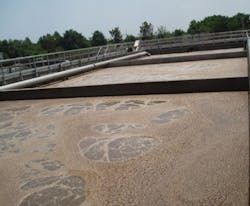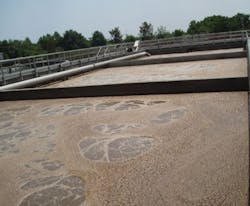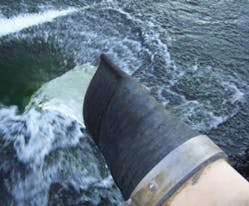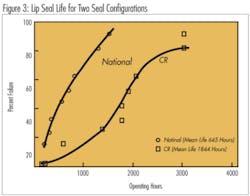By Allan R. Budris
As pointed out in prior columns, the second leading cause of pump break downs is bearing failures. This is because fewer than 10% of all ball bearings run long enough to succumb to normal fatigue failure (20,000 hours for an ANSI Pump). Most bearings fail at an early age because of static overload, wear, corrosion, lubricant failure, contamination, or overheating.
Particle contamination and corrosion related failures account for 52% of all of these bearing failures. Bearing housing seals, and more specifically the seal type, play a crucial role in this centrifugal pump reliability component. They serve to both retain the lubricant within the bearing housing and to exclude both solid and liquid contaminants that can find openings to infiltrate both the lubricant and the bearings.
To further complicate this issue, bearing housings breath in and out as they cool down and heat up with shut down and start up. If a path or opening exists (through a housing vent or bearing housing shaft seal) to the external environment, ambient air will be induced to flow into the housing. Figure 2 shows just how sensitive bearing reliability is to even small amounts of water. This is of most concern in humid environments.
Traditional Bearing Housing Seals
Many pumps today are still equipped with large open vents and short-lived, wear-prone lip seals. These “traditional” bearing housing seals are generally inadequate. When these seals are in good condition, they contact the shaft and contribute to friction drag and temperature rise in the bearing area. Then they wear out after as little as 2,000 to 4,000 operating hours. This wear (and any open vents) creates paths for the bearing housing to breath in contaminants.
Bearing Isolators / Labyrinth Seals
Improved protection can be provided with non-contacting labyrinth seals (sometimes called “bearing isolators”). Rotating labyrinth seals represent a commendable advancement over prior art. They have proven to give much better protection than either lip seals or standard stationary labyrinth seals.
However, the standard bearing isolator still has a fixed air gap that permits communication between bearing housing space and ambient environment. Non-contacting rotating labyrinth configurations cannot, therefore, provide a fully effective barrier against the intrusion of atmospheric dust or moisture.
Some bearing isolators have attempted to close up this air gap (at least during shut down) by use of O-rings that are intended to lift off slightly on running pumps. They are intended to reseal the bearing housing after the pump is stopped. However, even this device cannot be considered a totally effective housing seal for oil-lubricated pump bearings, since it is unable to fully prevent the interchange of vapors inside the bearing housing. If the O-rings lift off after restarting, ambient air at higher pressure gets into the bearing housing. If the rings do not lift off, then there is no gap between the rotor’s O-rings and the opposing stator surface. In this case, the rotating O-rings could undergo wear and again not perform as a “nothing in / nothing out” hermetic seal.
Rotating labyrinth seals seem to work best when the housing vent is plugged.
Magnetic Bearing Housing Seals
So what is a reliability focused pump user to do? Fortunately the aircraft and aerospace industries have brought us magnetic face seals, which are compact enough to replace lip seals, and provide a true hermetic seal for bearing housings. Research performed at Texas A&M University concluded that a magnetic seal leaks less than any other type of seal and operates with a low coefficient of friction, torque, electric power consumption and heat generation, and is an affordable way of sealing ball bearing housings.
In pumps equipped with magnetic bearing housing seals, the lubricant is totally contained while the atmosphere is effectively excluded. The shaft is sealed with magnetic seals at each end of the frame. In general, the rotary portion of the seal is fastened to the shaft by an O-ring that performs both clamping and sealing functions. The opposing component is O-ring mounted in a stationary fitting, which is then fitted into the pump housing or frame adapter. Instead of springs to hold the faces together, one of the components of a modern dual-face magnetic bearing housing seal is fitted with a series of small rare earth rod magnets.
Dual-face magnetic seals are the preferred configuration. The application options for dual-face magnetic bearing housing seals are almost limitless. They are presently used on many pump configurations, including horizontal and vertical pumps. Their dimensional envelope fits many locations where lip seals were originally installed. The external faces of the modern dual-face magnetic seals were originally designed for dry running and will do so without distress as long as the respective internal faces are kept cool, with marginal oil splash lubrication on the inner face of this seal.
To insure full hermetic sealing of the bearing housing, these magnetic shaft seals must be coupled with a diaphragm-type expansion chamber and “balanced” oilers (is used).
Limitations
To safeguard against blatant misapplication, the manufacturers of magnetic seals warn against dry running. As a matter of general policy, either continuous monitoring or other appropriate inspection and examination methods are advocated to ensure correct equipment oil levels. Fortunately, the bearing housings of properly designed pumps will always incorporate lube application methods that generate an oil fog that results in not only adequate bearing lubrication but also a thin coating of oil for the seal faces. Only the complete loss of oil could cause an unacceptable temperature increase at the inboard / outboard faces. Then again, that’s an academic concern since deprivation of lube oil would invite catastrophic bearing failure in any case.
For bearing housings in pure oil mist service, dual-face magnetic seals are provided with features that promote oil mist to coalesce on the seal faces. In that case, pre-lubrication of the faces will be required since, upon starting the equipment, oil mist will not instantly coalesce in sufficient amounts to form a separating film between seal faces. Properly applied and installed, modern dual-face magnetic seals have always won in laboratory tests (and case histories) against every other bearing housing seal. As a result, double-face magnetic bearing housing seals often show dramatic life cycle cost savings due to the reduction of operating and maintenance costs.
Conclusions
Reliability focused pump users can improve the life cycle costs of their pump installations by upgrading the bearing housing shaft seals to avoid premature bearing failures from oil contamination. And finally, it should be noted that, in most cases, even the simplest oil lubrication design will outlast grease lubricated pumps, especially those with sealed for life bearings, since the oil lubricated bearings will typically run cooler with superior lubrication.
WW
Reference: “Pump User’s Handbook, Life Extension, third Edition” by Heinz P. Bloch & Allan R. Budris, Third edition, 2010, by Fairmont Press, Inc.
More WaterWorld Current Issue Articles
More WaterWorld Archives Issue Articles






